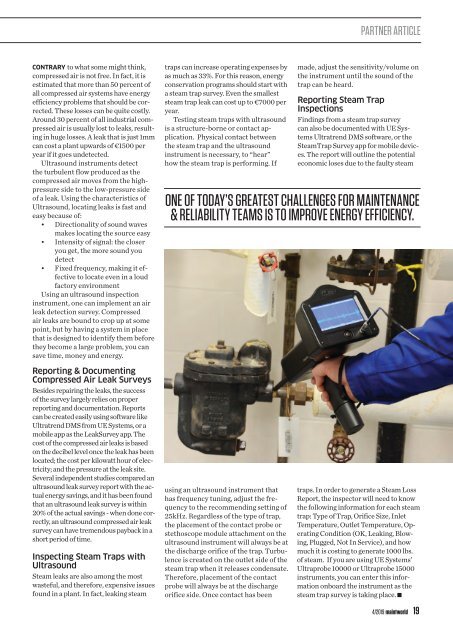Maintworld 4/2019
Machine Learning – Not a Gold-Plated Silver-Bullet Solution to Operational Woes // A Data-Driven Approach to Online Monitoring of Roller Bearings // Using Ultrasound to Enhance Energy Efficiency
Machine Learning – Not a Gold-Plated Silver-Bullet Solution to Operational Woes // A Data-Driven Approach to Online Monitoring of Roller Bearings // Using Ultrasound to Enhance Energy Efficiency
Create successful ePaper yourself
Turn your PDF publications into a flip-book with our unique Google optimized e-Paper software.
PARTNER ARTICLE<br />
CONTRARY to what some might think,<br />
compressed air is not free. In fact, it is<br />
estimated that more than 50 percent of<br />
all compressed air systems have energy<br />
efficiency problems that should be corrected.<br />
These losses can be quite costly.<br />
Around 30 percent of all industrial compressed<br />
air is usually lost to leaks, resulting<br />
in huge losses. A leak that is just 1mm<br />
can cost a plant upwards of €1500 per<br />
year if it goes undetected.<br />
Ultrasound instruments detect<br />
the turbulent flow produced as the<br />
compressed air moves from the highpressure<br />
side to the low-pressure side<br />
of a leak. Using the characteristics of<br />
Ultrasound, locating leaks is fast and<br />
easy because of:<br />
• Directionality of sound waves<br />
makes locating the source easy<br />
• Intensity of signal: the closer<br />
you get, the more sound you<br />
detect<br />
• Fixed frequency, making it effective<br />
to locate even in a loud<br />
factory environment<br />
Using an ultrasound inspection<br />
instrument, one can implement an air<br />
leak detection survey. Compressed<br />
air leaks are bound to crop up at some<br />
point, but by having a system in place<br />
that is designed to identify them before<br />
they become a large problem, you can<br />
save time, money and energy.<br />
traps can increase operating expenses by<br />
as much as 33%. For this reason, energy<br />
conservation programs should start with<br />
a steam trap survey. Even the smallest<br />
steam trap leak can cost up to €7000 per<br />
year.<br />
Testing steam traps with ultrasound<br />
is a structure-borne or contact application.<br />
Physical contact between<br />
the steam trap and the ultrasound<br />
instrument is necessary, to “hear”<br />
how the steam trap is performing. If<br />
made, adjust the sensitivity/volume on<br />
the instrument until the sound of the<br />
trap can be heard.<br />
Reporting Steam Trap<br />
Inspections<br />
Findings from a steam trap survey<br />
can also be documented with UE Systems<br />
Ultratrend DMS software, or the<br />
SteamTrap Survey app for mobile devices.<br />
The report will outline the potential<br />
economic loses due to the faulty steam<br />
ONE OF TODAY’S GREATEST CHALLENGES FOR MAINTENANCE<br />
& RELIABILITY TEAMS IS TO IMPROVE ENERGY EFFICIENCY.<br />
Reporting & Documenting<br />
Compressed Air Leak Surveys<br />
Besides repairing the leaks, the success<br />
of the survey largely relies on proper<br />
reporting and documentation. Reports<br />
can be created easily using software like<br />
Ultratrend DMS from UE Systems, or a<br />
mobile app as the LeakSurvey app. The<br />
cost of the compressed air leaks is based<br />
on the decibel level once the leak has been<br />
located; the cost per kilowatt hour of electricity;<br />
and the pressure at the leak site.<br />
Several independent studies compared an<br />
ultrasound leak survey report with the actual<br />
energy savings, and it has been found<br />
that an ultrasound leak survey is within<br />
20% of the actual savings - when done correctly,<br />
an ultrasound compressed air leak<br />
survey can have tremendous payback in a<br />
short period of time.<br />
Inspecting Steam Traps with<br />
Ultrasound<br />
Steam leaks are also among the most<br />
wasteful, and therefore, expensive issues<br />
found in a plant. In fact, leaking steam<br />
using an ultrasound instrument that<br />
has frequency tuning, adjust the frequency<br />
to the recommending setting of<br />
25kHz. Regardless of the type of trap,<br />
the placement of the contact probe or<br />
stethoscope module attachment on the<br />
ultrasound instrument will always be at<br />
the discharge orifice of the trap. Turbulence<br />
is created on the outlet side of the<br />
steam trap when it releases condensate.<br />
Therefore, placement of the contact<br />
probe will always be at the discharge<br />
orifice side. Once contact has been<br />
traps. In order to generate a Steam Loss<br />
Report, the inspector will need to know<br />
the following information for each steam<br />
trap: Type of Trap, Orifice Size, Inlet<br />
Temperature, Outlet Temperature, Operating<br />
Condition (OK, Leaking, Blowing,<br />
Plugged, Not In Service), and how<br />
much it is costing to generate 1000 lbs.<br />
of steam. If you are using UE Systems’<br />
Ultraprobe 10000 or Ultraprobe 15000<br />
instruments, you can enter this information<br />
onboard the instrument as the<br />
steam trap survey is taking place.<br />
4/<strong>2019</strong> maintworld 19

















